Table of Contents
- Introduction
- Editor’s Choice
- Precision Farming Market Statistics
- Adoption of Different Advanced Technologies in Farming
- IoT Applications in Precision Farming Statistics
- Precision Farming Technology Investment Statistics
- Status and Availability of Precision Farming Technology Statistics
- Retailer Use of Precision Agriculture Technology for Their Business
- Challenges to the Adoption of Precision Farming Statistics
- Recent Developments
- Conclusion
- FAQs
Introduction
Precision Farming Statistics: Precision farming, also termed precision agriculture, employs GPS, sensors, and drones to enhance crop yield while reducing waste and environmental harm. Farmers can strategically manage resources like water, fertilizers, and pesticides by integrating these tools.
This method enables accurate field mapping, crop health monitoring, and tailored input applications based on specific conditions.
The advantages encompass improved yield, resource conservation, sustainability, profitability, and data-driven decision-making.
Precision farming embodies a contemporary and sustainable agricultural approach. The leveraging technology and data to address the imperative of feeding a growing population while advocating for environmental responsibility.

Editor’s Choice
- In 2023, the precision farming market generated USD 10.5 billion in revenue.
- Approximately 40.46% of respondents utilize sensors for monitoring machine conditions, enabling timely maintenance and minimizing downtime.
- Unmanned vehicles, including Autonomous Tractors and other autonomous machinery, are widely adopted. Approximately 89.31% of respondents utilize these advanced tools for tasks such as planting, cultivation, and harvesting.
- Approximately 32.06% of respondents utilize microclimate sensors to monitor environmental conditions such as temperature, humidity, and air quality, ensuring optimal living conditions for livestock.
- Approximately 12.98% of respondents utilize milking robots, which automate the milking process and provide benefits such as increased milk yield, reduced labor costs, and enhanced animal welfare.
- GPS guidance systems with automatic control (autosteer) for fertilizer/chemical application saw a significant rise from 78% to 90%. Indicating a growing reliance on automated navigation systems in agricultural machinery.
- Many farmers are deeply concerned about the soaring prices of inputs. With nearly 67 percent expressing worry about how this will impact their profitability over the next few years.
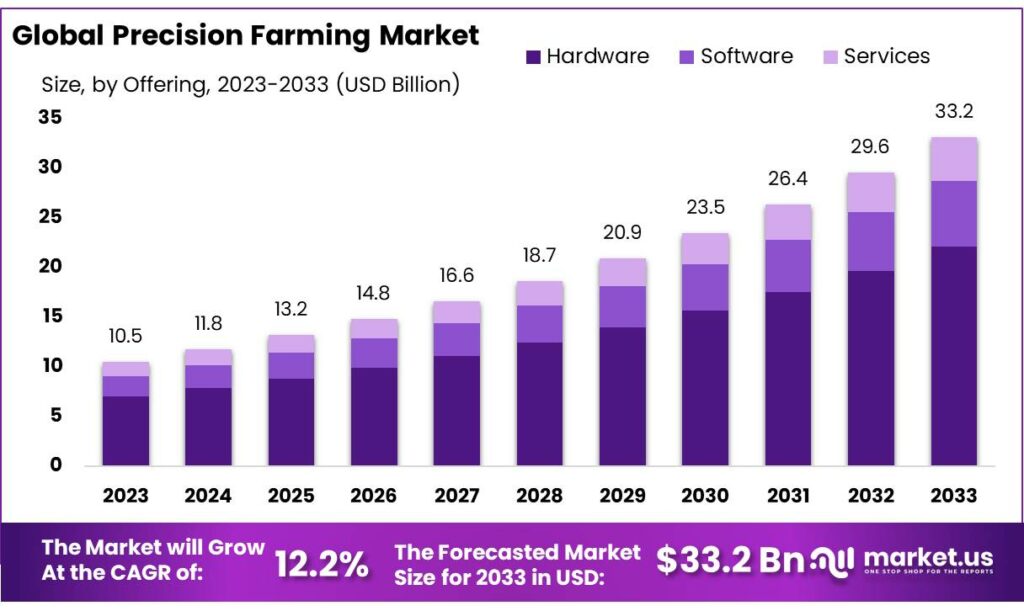
Precision Farming Market Statistics
Global Precision Farming Market Size Statistics
- The precision farming market is witnessing steady growth. With revenues projected to increase consistently over the next decade at a CAGR of 12.2%.
- In 2023, the market generated USD 10.5 billion in revenue, which rose to USD 11.8 billion in 2024.
- This growth trajectory is expected to continue, with revenues forecasted to reach USD 13.2 billion in 2025 and USD 14.8 billion in 2026.
- By 2027, the market is anticipated to exceed USD 16.6 billion. Followed by further expansions to USD 18.7 billion in 2028 and USD 20.9 billion in 2029.
- The upward trend persists, with revenues projected to reach USD 23.5 billion in 2030. USD 26.4 billion in 2031, and USD 29.6 billion in 2032.
- By 2033, the precision farming market is anticipated to grow substantially. Surpassing USD 33.2 billion in revenue.
- This consistent expansion underscores the increasing adoption and recognition of the benefits of precision farming technologies in enhancing agricultural productivity and sustainability.
(Source: market.us)
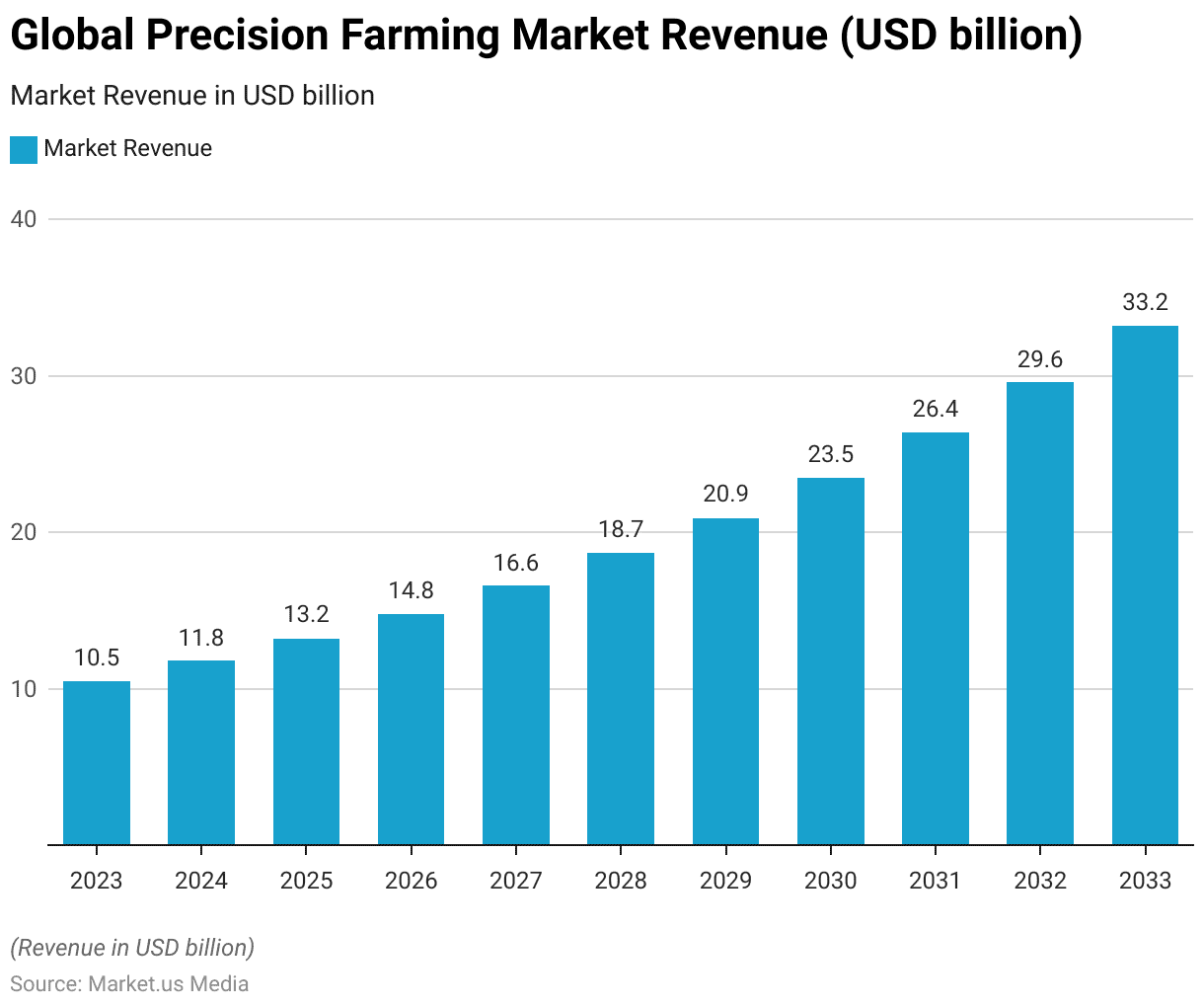
Adoption of Different Advanced Technologies in Farming
Use of Sensors in Crop Production
- Sensors play a crucial role in modern crop production technology. Providing valuable insights and enhancing efficiency across various aspects of agricultural operations.
- Approximately 40.46% of respondents utilize sensors for monitoring machine conditions, enabling timely maintenance and minimizing downtime.
- Another significant application, with 50.38% of respondents, is using sensors to track machine position, facilitating precise and automated farming tasks.
- Furthermore, plant protection and nutrition sensors are widely adopted. With 53.44% of respondents leveraging these technologies to optimize inputs and enhance crop health.
- 58.02% of respondents utilize weather stations to provide critical data for informed decision-making regarding irrigation, pest management, and harvesting activities.
- However, the adoption rate for crop anomaly sensors is comparatively lower. Only 21.37% of respondents utilize these sensors to detect and address irregularities in crop monitoring growth.
- Integrating sensors in crop production technology reflects a growing emphasis on data-driven approaches to improve productivity, sustainability, and resilience in modern agriculture.
(Source: MDPI)
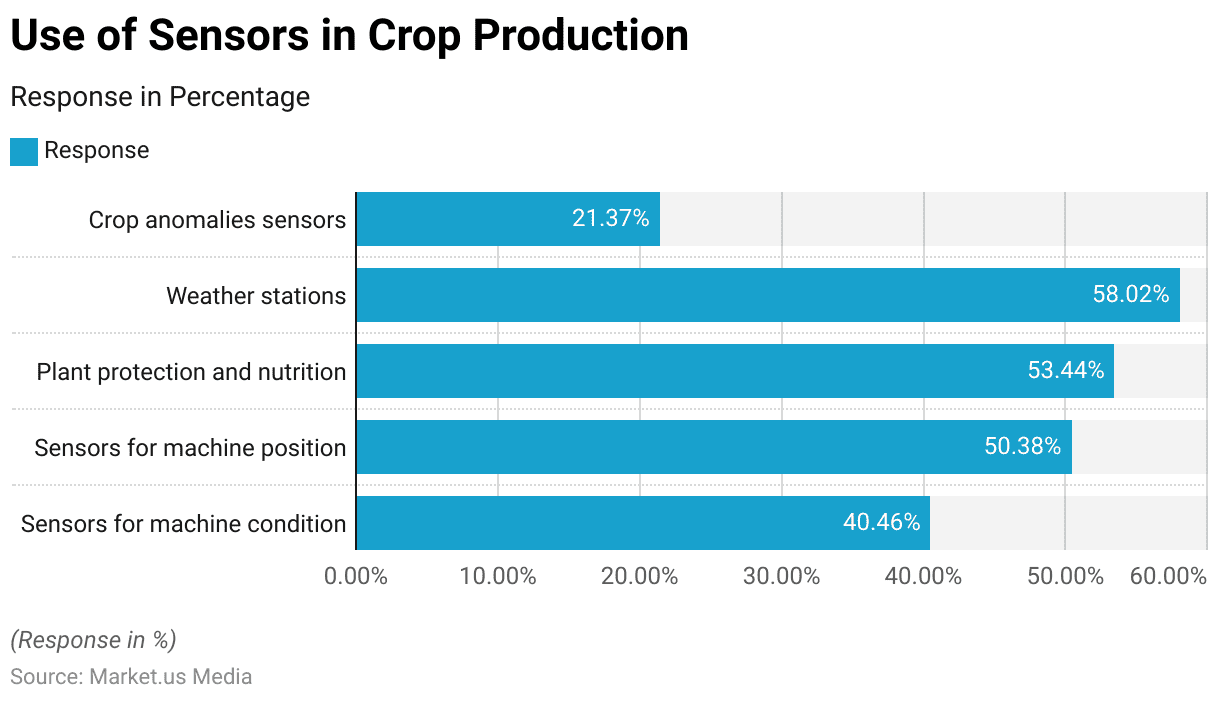
Use of Machines in Crop Production
- Machines play a pivotal role in crop production technology, offering various functionalities to enhance efficiency and productivity in agricultural operations.
- Unmanned vehicles, including tractors and other autonomous machinery, are widely adopted. Approximately 89.31% of respondents utilize these advanced tools for tasks such as planting, cultivation, and harvesting.
- Navigation and optimization systems are also prevalent, with 61.83% of respondents leveraging these technologies to enhance precision and efficiency in field operations.
- Additionally, Agriculture Drones are increasingly utilized for soil condition monitoring. With 33.59% of respondents employing these aerial devices to collect data on soil health, moisture levels, and crop development.
- The widespread adoption of machines in crop production underscores the agricultural industry’s commitment to embracing innovative technologies to improve yields. Reduce resource inputs, and promote sustainable farming practices.
(Source: MDPI)
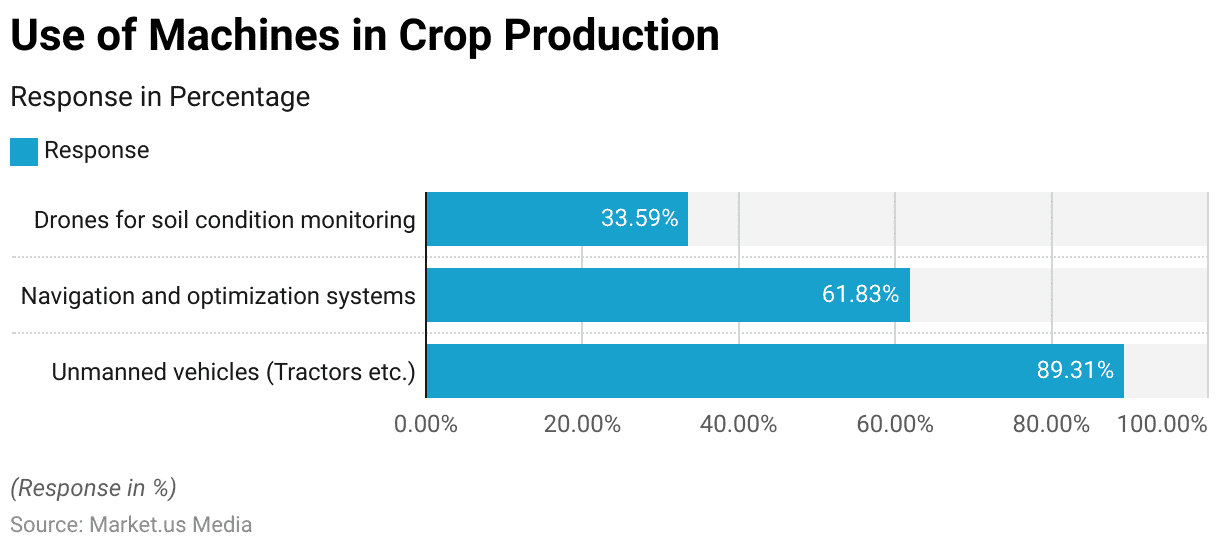
Use of Sensors and IoT Devices in Livestock Production
- Integrating sensors and Internet of Things (IoT) devices in livestock production technology is increasingly prevalent. The various applications are aimed at enhancing animal welfare and farm management.
- Approximately 32.06% of respondents utilize microclimate sensors to monitor environmental conditions such as temperature, humidity, and air quality, ensuring optimal living conditions for livestock.
- Smart collars are also widely adopted, with 42.75% of respondents employing them for health monitoring. Allowing farmers to track vital signs and detect early signs of illness or distress in animals.
- Moreover, smart collars for movement monitoring are utilized by 46.56% of respondents, enabling real-time tracking of animal behavior and activity levels, which can inform decisions related to feeding, breeding, and health management.
- Additionally, smart collars for nutrition monitoring, also utilized by 32.06% of respondents, provide insights into feeding patterns and nutritional intake. Facilitating customized feeding regimens and optimizing animal nutrition.
- Using sensors and IoT devices in livestock production reflects a growing emphasis on data-driven approaches to improve animal health, welfare, and farm efficiency.
(Source: MDPI)
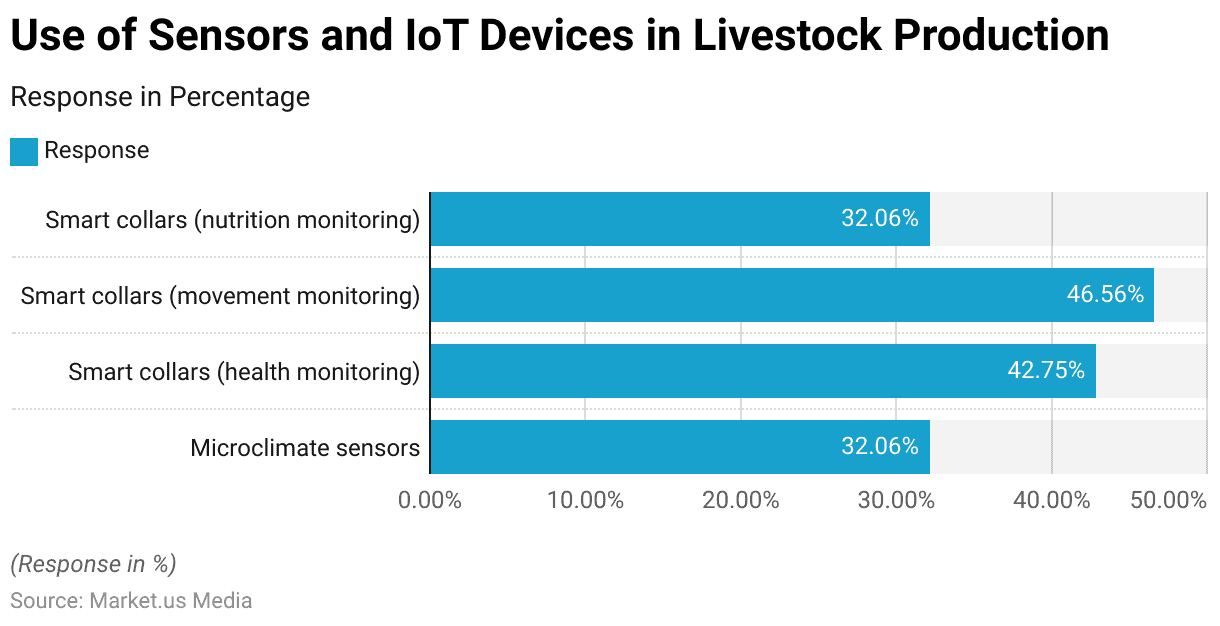
Use of Robots in Livestock Production
- Robots are increasingly integrated into livestock production technology, offering innovative solutions to streamline farm operations and improve efficiency.
- Approximately 12.98% of respondents utilize milking robots. Which automates the milking process and provide benefits such as increased milk yield, reduced labor costs, and enhanced animal welfare.
- Feeding robots are also gaining traction, with 19.85% of respondents leveraging these automated systems to accurately dispense feed to livestock based on nutritional requirements and feeding schedules.
- The adoption of robots in livestock production reflects a shift towards automation and precision farming practices, enabling farmers to optimize resource utilization, enhance productivity, and maintain high standards of animal care.
(Source: MDPI)

IoT Applications in Precision Farming Statistics
Application of IoT in Agriculture Market – By Segment
- The worldwide market for Internet of Things (IoT) applications in agriculture demonstrates significant growth across various segments from 2020 to 2026.
- In the precision crop farming segment, the market value surged from $7,285.3 million in 2020 to $8,280.6 million in 2021 and is projected to reach $13,134 million by 2026.
- Similarly, the livestock monitoring and management segment witnessed notable growth. With market values rising from $4,834.1 million in 2020 to $5,503.3 million in 2021 and an anticipated increase to $8,797.6 million by 2026.
- Indoor farming also experienced substantial growth, with market values increasing from $3,234.1 million in 2020 to $3,707.4 million in 2021 and projected to reach $6,086.9 million by 2026.
- Additionally, the aquaculture segment demonstrated significant growth. With market values rising from $2,011.1 million in 2020 to $2,327.2 million in 2021 and forecasted to reach $4,016 million by 2026.
- Other segments also showed growth trends, with market values increasing from $1,152.5 million in 2020 to $1,285.1 million in 2021 and anticipated growth to $1,818.7 million by 2026.
- Overall, the IoT application market in agriculture is witnessing robust global expansion, driven by the increasing adoption of technology-driven solutions to optimize farming practices and improve efficiency across various agricultural segments.
(Source: Statista)

Precision Farming Technology Investment Statistics
- Between 2017 and 2022, agriculture technology funding investments worldwide experienced significant fluctuations. Reflecting the evolving landscape of technological innovation in the agricultural sector.
- Commencing at 12.2 billion U.S. dollars in 2017, the investment surged to 21.1 billion in 2018, indicative of a burgeoning interest in agricultural technology solutions.
- This trend persisted in 2019, with funding reaching 21.5 billion dollars, sustaining momentum in the sector.
- 2020 witnessed a notable spike, with investments soaring to 27.7 billion dollars. Underscoring the increasing reliance on technological advancements to address agricultural challenges.
- Subsequently, in 2021, there was a remarkable surge to 53.2 billion dollars. Signifying a substantial leap in investor confidence and a heightened focus on agricultural innovation.
- However, in 2022, the investment landscape experienced a slight downturn. With funding totaling 29.6 billion dollars, albeit significantly higher than the initial years of the analyzed period.
- This trajectory underscores the growing recognition of agriculture technology’s potential to revolutionize farming practices and enhance global food security.

Status and Availability of Precision Farming Technology Statistics
- The dealer offering of precision agriculture services has shown notable increases across various categories from 2019 to 2022.
- Cost/profit mapping services witnessed a significant rise in adoption, increasing from 38% in 2019 to 55% in 2022, indicating a growing recognition of the importance of financial analysis in farm management.
- Field mapping with Geographic Information Systems (GIS) increased from 85% to 90%, reflecting the continued integration of spatial data analysis in precision agriculture practices.
- Similarly, grid or zone soil sampling remained widely adopted, slightly increasing from 90% to 91%.
- Guidance and autosteer sales and support also saw a notable uptick, rising from 38% to 46%, indicating increased demand for automated navigation systems in farm machinery.
- The utilization of satellite and aerial imagery surged from 70% to 80%, highlighting the growing reliance on remote sensing technologies for farm management.
- Additionally, various aspects of variable rate technology (VRT) application, including fertilizer, lime, and pesticide applications. Witnessed significant increases in adoption rates. VRT pesticide application is experiencing a notable rise from 20% to 50%.
- Furthermore, sales and support for yield monitors and other data analysis tools showed considerable growth, with adoption rates increasing from 40% to 46% and 63% to 70%, respectively.
- Overall, the data indicates dealers’ widespread and increasing adoption of precision agriculture services. Reflecting the industry’s ongoing embrace of advanced technologies and data-driven approaches to optimize farm operations and increase productivity.
(Source: 2019 Precision Agriculture Dealership Survey)
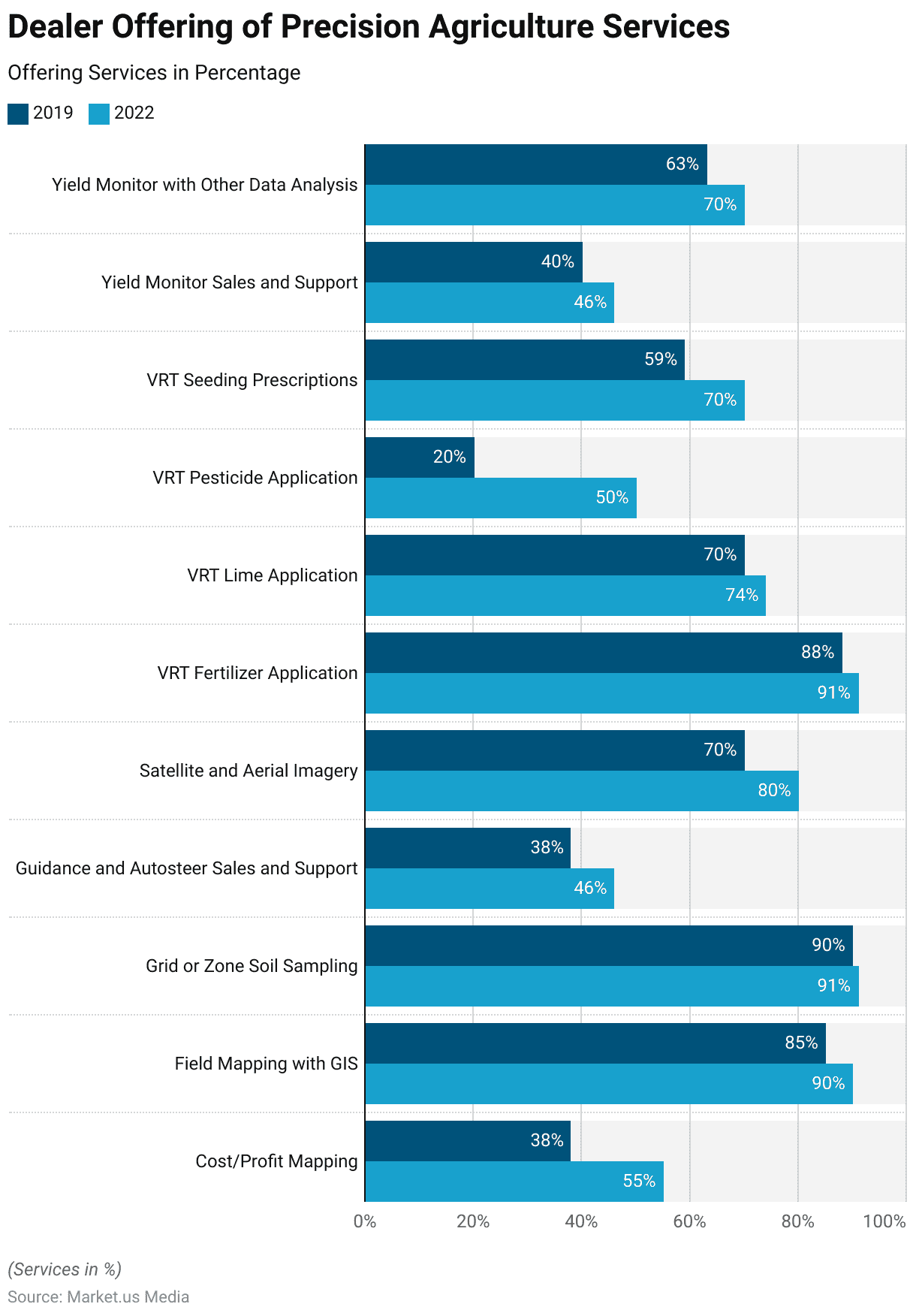
Retailer Use of Precision Agriculture Technology for Their Business
- From 2017 to 2019, there has been a notable increase in the adoption of precision agriculture technology among retailers for their business operations.
- GPS guidance systems with automatic control (autosteer) for fertilizer/chemical application saw a significant rise from 78% to 90%. Indicating a growing reliance on automated navigation systems in agricultural machinery.
- Additionally, there was a slight increase in the adoption of precision agronomic services for customers, with a rise from 81% to 83%. Reflecting the continued integration of advanced technologies to meet customer demands.
- Auto sprayer boom section or nozzle control also experienced a modest increase from 73% to 75%. Indicating a growing emphasis on precision application of inputs.
- Satellite/aerial imagery for internal dealership purposes saw a substantial jump from 52% to 68%. Highlighting the increasing utilization of remote sensing technologies for internal operations.
- Similarly, there were increases in the adoption of GPS guidance systems with manual control, field mapping with GIS, and other precision technologies. Demonstrating a broader trend towards embracing data-driven approaches in retail agricultural operations.
- Despite some technologies experiencing more modest growth, overall, there is a clear upward trend in the integration of precision agriculture technology among retailers. Signaling a shift towards more efficient and technologically advanced farming practices.
(Source: 2019 Precision Agriculture Dealership Survey)
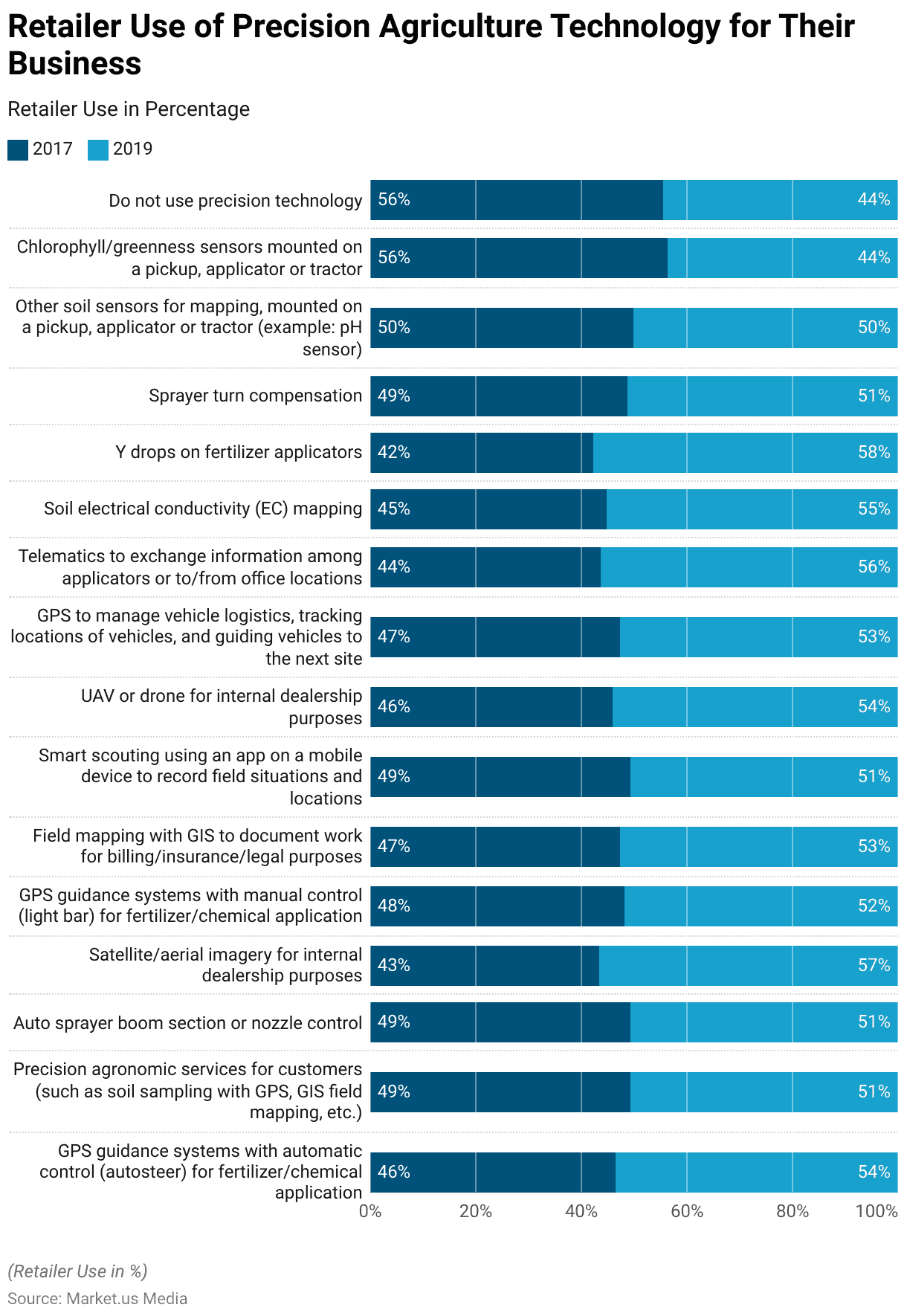
Challenges to the Adoption of Precision Farming Statistics
- Many farmers are deeply concerned about the soaring prices of inputs, with nearly 67 percent expressing worry about how this will impact their profitability over the next few years.
- These concerns are backed by reports revealing substantial spikes in global input costs, ranging from around 80 percent to 250 percent in recent times.
- South American farmers have been hit the hardest, facing an alarming rise of about 247 percent. While their Asian counterparts have seen comparatively lesser increases, hovering around 82 percent.
- Even though farmers enjoy favorable sales prices for their produce, the unpredictable nature of commodity markets and the relentless surge in input expenses cast a shadow of uncertainty over their future profitability.
(Source: Mckinsey)
Recent Developments
New Product Launches:
- Agri-tech companies have been introducing innovative precision farming technologies to enhance agricultural efficiency.
- For example, in 2023, John Deere launched its latest precision farming equipment. Including advanced GPS-guided tractors and automated planting systems. Aimed at improving crop yields and reducing input costs.
Acquisitions and Mergers:
- In the precision farming sector, there have been several strategic acquisitions and mergers aimed at expanding market presence and integrating complementary technologies.
- For instance, in 2023, Trimble acquired a leading agricultural data analytics company to enhance its precision farming solutions suite.
Funding and Investments:
- Investment in precision farming technology startups has been robust, with venture capital firms and agricultural corporations injecting funds into companies developing cutting-edge solutions.
- In 2023, a notable precision farming startup secured significant funding to scale up its operations and further develop its innovative products.
Collaborations and Partnerships:
- Collaboration among precision farming technology providers and agricultural stakeholders has been increasing.
- Partnerships between hardware manufacturers, software developers, and agricultural producers aim to integrate diverse technologies into seamless farming solutions.
- In 2023, a leading precision farming software company partnered with a major agribusiness conglomerate to deploy integrated precision farming systems on large-scale farms.
Market Expansion and Adoption:
- The adoption of precision farming technologies has been steadily growing worldwide. Driven by the need to optimize agricultural inputs, increase productivity, and mitigate environmental impact.
- Market expansion efforts by precision farming companies have focused on regions with significant agricultural activities, such as North America, Europe, and parts of Asia.
Conclusion
Precision Farming Statistics – Precision farming represents a transformative approach to agriculture. Leveraging advanced technologies to optimize crop production while minimizing waste and environmental impact.
The widespread adoption of precision farming techniques offers numerous benefits, including increased yield, resource efficiency, improved sustainability, enhanced profitability, and data-driven decision-making.
Despite challenges such as rising input costs and market volatility, the industry continues to expand and innovate.
With ongoing research and technological advancements, precision farming holds promise for addressing the pressing demands of feeding a growing global population while promoting environmental stewardship and sustainability in agriculture.
FAQs
Precision farming, also known as precision agriculture, is an advanced approach to farming that utilizes technology such as GPS, sensors, drones, and data analytics to optimize crop production while minimizing waste and environmental impact.
Precision farming incorporates various technologies, including GPS for precise field mapping and navigation, sensors for monitoring soil and crop health, drones for aerial imaging, and data analytics software for decision-making.
Precision farming offers numerous benefits, including increased crop yield, resource efficiency, improved sustainability, enhanced profitability, and data-driven decision-making, leading to optimized farm operations.
Precision farming helps farmers make informed decisions about resource management, such as water, fertilizers, and pesticides, by providing real-time data on soil conditions, weather patterns, and crop health. This leads to more efficient use of resources and improved crop yields.
Farmers interested in adopting precision farming practices can start by researching, seeking guidance from agricultural extension services or technology providers. Gradually integrating technology into their farming operations based on their needs and resources.
Discuss your needs with our analyst
Please share your requirements with more details so our analyst can check if they can solve your problem(s)



